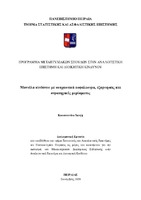Μοντέλα κινδύνου με στοχαστικά ασφάλιστρα, εξαρτήσεις και στρατηγικές μερίσματος
Risk models with stochastic premiums, dependencies and dividents strategies

Προβολή/
Λέξεις κλειδιά
Χρεοκοπία ; Gerber-Shiu function ; Στρατηγικές μερίσματος ; Εξαρτήσεις απαιτήσεων και ασφαλίστρων ; Μετασχηματισμός Laplace του χρόνου χρεοκοπίαςΠερίληψη
Η διπλωματική εργασία γενικεύει το κλασικό πρότυπο της θεωρίας κινδύνων στο οποίο τo συνολικό εισόδημα από ασφάλιστρα, που καταβάλλεται από τους πελάτες, ακολουθεί μια προσδιοριστική γραμμική συνάρτηση του χρόνου με σταθερό θετικό ρυθμό είσπραξης ασφαλίστρου. Μια πιο ρεαλιστική θεώρηση η οποία λαμβάνει υπ’ όψιν την αβεβαιότητα στις αφίξεις των πελατών είναι αυτή των στοχαστικών ασφαλίστρων. Στην εργασία μελετώνται διάφορα μοντέλα της διαδικασίας πλεονάσματος με τα μεγέθη των ατομικών ασφαλίστρων να είναι τυχαία, καθώς επίσης και κάποιες μορφές εξάρτησης μεταξύ του ύψους ατομικής απαίτησης, του ύψους ατομικών ασφαλίστρων και των ενδιάμεσων χρόνων εμφάνισης των κινδύνων και είσπραξης των ασφαλίστρων. Αναλύονται διάφορα μέτρα κινδύνου, όπως για παράδειγμα η πιθανότητα χρεοκοπίας ή ο χρόνος μέχρι τη χρεοκοπία, μέσω της ανάλυσης της αναμενόμενης προεξοφλημένης συνάρτησης ποινής των Gerber-Shiu. Για ορισμένα από τα υπό θεώρηση μοντέλα μελετάται επιπλέον και η κατανομή των μερισμάτων θεωρώντας για τις αντίστοιχες στοχαστικές διαδικασίες πλεονάσματος διάφορες στρατηγικές καταβολής μερίσματος.
Το Κεφάλαιο 1 αποτελεί ένα εισαγωγικό μέρος στο οποίο δίνονται βασικές έννοιες από τη θεωρία χρεοκοπίας, μια σύντομη περιγραφή του κλασικού μοντέλου της θεωρίας κινδύνων, η αναμενόμενη προεξοφλημένη συνάρτηση ποινής των Gerber-Shiu και γίνεται αναφορά στη επίλυση της ελλειμματικής ανανεωτικής εξίσωσης που ικανοποιεί αυτή η συνάρτηση.
Στο Κεφάλαιο 2 εξετάζονται δύο μοντέλα κινδύνου με στοχαστικά ασφάλιστρα χωρίς εξαρτήσεις. Στο πρώτο μοντέλο το ύψος των ασφαλίστρων είναι ίσο με τον αριθμό των ασφαλισμένων ατόμων που περιγράφεται από μια διαδικασία Poisson, ενώ στο δεύτερο μοντέλο οι διαδικασίες εμφάνισης των κινδύνων και των ασφαλίστρων ακολουθούν σύνθετες διαδικασίες Poisson.
To Κεφάλαιο 3 θεωρεί δύο μοντέλα κινδύνου με στοχαστικά ασφάλιστρα και εξαρτήσεις. Αρχικά εξετάζεται η περίπτωση όπου το μέγεθος μιας απαίτησης επηρεάζει τις κατανομές του χρόνου εμφάνισης της επόμενης απαίτησης και του μεγέθους του ατομικού ασφαλίστρου και στη συνέχεια εξετάζεται το μοντέλο στο οποίο ο ενδιάμεσος χρόνος μεταξύ διαδοχικών απαιτήσεων προσδιορίζει τις κατανομές για τα μεγέθη της επόμενης απαίτησης και του ατομικού ασφαλίστρου.
Στο Κεφάλαιο 4 μελετώνται δύο μοντέλα με στοχαστικά ασφάλιστρα, εξαρτήσεις καθώς και στρατηγικές μερισμάτων. Στο μεν πρώτο, κάτω από τη στρατηγική σταθερού μερίσματος, υπάρχει εξάρτηση ανάμεσα στα μεγέθη των απαιτήσεων και τους χρόνους εμφάνισης αυτών και στο δεύτερο, υπό τη στρατηγική μερίσματος κατωφλίου, εξετάζονται εξαρτήσεις ανάμεσα στις απαιτήσεις και στους χρόνους εμφάνισης αυτών και συνάμα εξαρτήσεις ανάμεσα στα μεγέθη των ασφαλίστρων και τους χρόνους που αυτά εμφανίζονται.
Στο Παράρτημα δίνονται τα σχετικά μαθηματικά εργαλεία (μετασχηματισμός Laplace, τελεστής Dickson-Hipp κ.ά.) που χρησιμοποιούνται στην εργασία.
Το πρόγραμμα Mathematica χρησιμοποιήθηκε για την εκτέλεση συμβολικού λογισμού, αριθμητικών πράξεων και δημιουργία γραφημάτων.


